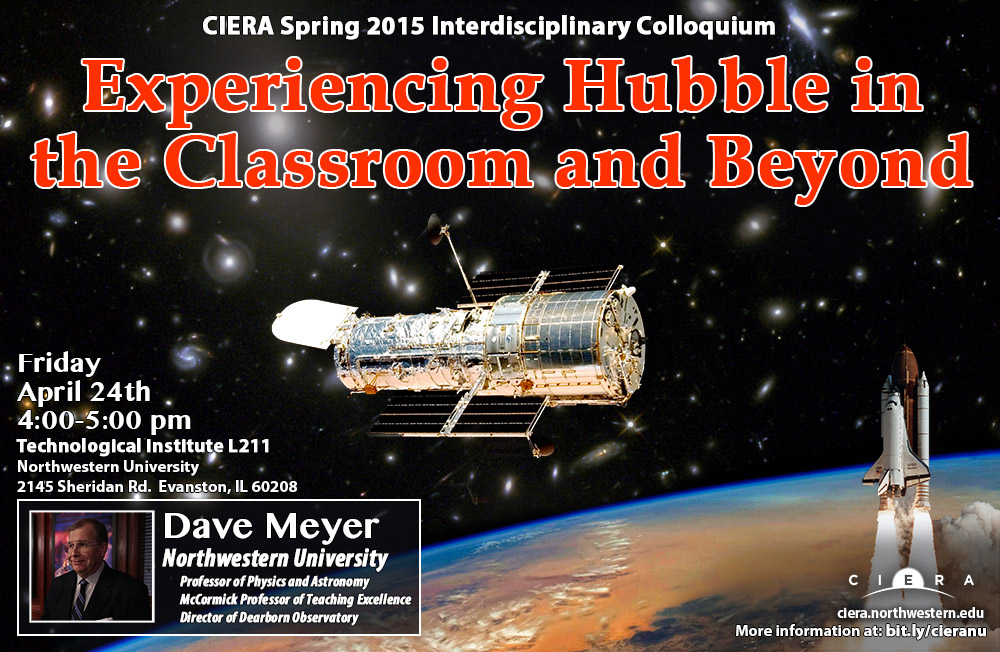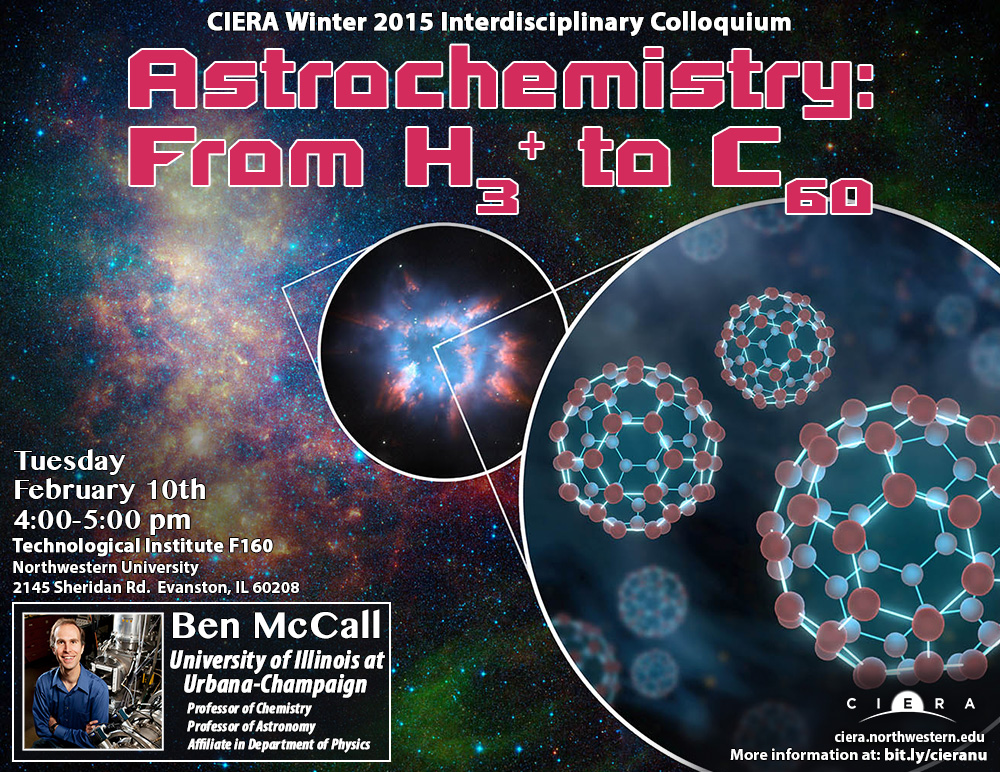| CIERA Spring Interdisciplinary Colloquium 2015 |
| April 24 4:00 pm Tech L211 |
Dave Meyer 
Experiencing Hubble in the Classroom and Beyond The Hubble Space Telescope was launched 25 years ago on April 24, 1990. Its stunning images of cosmic vistas ranging from star-forming nebulae to colliding galaxies have captivated public attention and inspired students of all ages. In this talk, I will focus on how Hubble's images and research findings have changed the teaching of introductory astronomy over the past 25 years. I will also go beyond the classroom to discuss how Hubble's images have become an outstanding beacon to promote public science education. Along the way, we will explore the history of Hubble in the context of its early troubles, its long-term future, and why it continues to be such a special telescope. |
| CIERA Winter Interdisciplinary Colloquium 2015 |
| Feb. 10 4:00 pm Tech F160 |
Ben McCall

Astrochemistry: From H3+ to C60 Our galaxy’s interstellar medium contains roughly 1016 times more molecules than the Earth, and over 150 different interstellar molecules have been definitively identified by high resolution spectroscopy. However, our inventory of this vast chemical repository remains very incomplete, and our understanding of the chemical and physical processes that produce and destroy these molecules remains primitive. Our group has been engaged in an interdisciplinary program of laboratory experiments and astronomical observations aimed at answering some of the key unsolved questions in “astrochemistry.” In this talk, I will describe how a combination of astronomical observations and chemical kinetics measurements of H3+ (the simplest polyatomic molecule) have taught us about low energy cosmic rays and the processes that govern the ortho:para ratio of H3+ in diffuse interstellar clouds. I will describe our development of a new laboratory technique for molecular ion spectroscopy – noise-immune cavity-enhanced optical heterodyne velocity modulation spectroscopy (NICE-OHVMS) – which we expect will ultimately enable the astronomical detection of more complex molecular ions. Finally, I will describe our ongoing program to perform rotationally-resolved infrared spectroscopy of large neutral molecules such as C60. |
| CIERA Fall Interdisciplinary Colloquium 2014 |
| Oct. 28 4:00 pm Tech F160 |
James Stone Princeton University Professor of Astrophysical Sciences and Applied and Computational Mathematics Associate Director, Princeton Institute for Computational Science and Engineering The Role of Computation in Astrophysical Plasma Dynamics Most of the visible matter in the Universe is a plasma -- that is a dilute gas of electrons, ions, and neutral particles. The time-dependent dynamics of astrophysical plasmas are described by a system of nonlinear coupled partial differential equations. Often additional systems of equations that describe more physics, such as self-gravity and radiation transport, must be coupled to the underlying equations of motion. Over the past few decades, computational methods have emerged as the most powerful approach for solving such complex problems. In this talk, I will begin by introducing some fundamental challenges in theoretical astrophysics that require detailed modeling of plasma dynamics, such as star formation, and understanding how compact objects such as black holes accrete plasma from interstellar space. I will then describe a variety of numerical algorithms that have been developed to model astrophysical plasma dynamics, including new methods for calculating time-dependent radiation transport in relativistic flows. Efficient implementation of these methods on modern parallel high-performance computing systems is crucial, and will be discussed. Finally, I will describe some of the many new insights that have come from applying computational methods to studies of a variety of problems, from black hole accretion flows to star formation in the turbulent interstellar medium.
|
Past CIERA Interdisciplinary Colloquia
